IIT ADACC Chapter 8 Assessment Booklet: Finance and Auditing
VerifiedAdded on 2022/09/01
|22
|3655
|16
Homework Assignment
AI Summary
This document presents the solutions to the ADACC Chapter 8 assessment, focusing on audit and reporting on financial systems and records. The assessment includes short answer questions addressing various aspects of auditing, such as the application of different international standards (ISAs, ISREs, ISAEs, ISRSs) to specific engagements, limitations of providing absolute assurance, identification of inherent and control risks within a company, and the assessment of audit risk related to customer groups. The solutions also delve into the analysis of financial ratios, the importance and practical application of materiality, the use of generalized audit software, and the rationale behind using non-statistical sampling. The document aims to provide comprehensive answers to the assessment questions, demonstrating an understanding of key auditing concepts and principles.
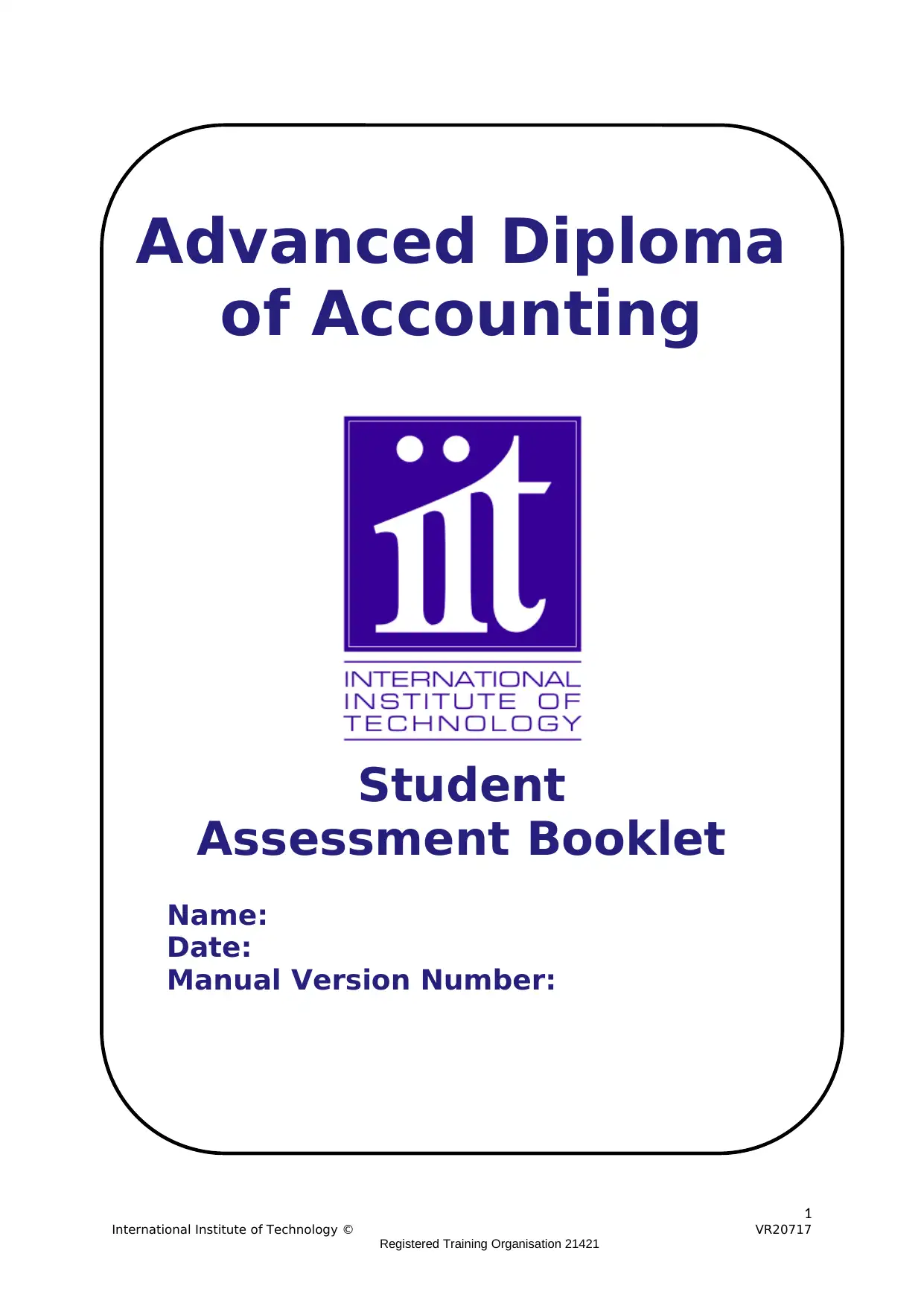
Advanced Diploma
of Accounting
Student
Assessment Booklet
Name:
Date:
Manual Version Number:
1
International Institute of Technology © VR20717
Registered Training Organisation 21421
of Accounting
Student
Assessment Booklet
Name:
Date:
Manual Version Number:
1
International Institute of Technology © VR20717
Registered Training Organisation 21421
Paraphrase This Document
Need a fresh take? Get an instant paraphrase of this document with our AI Paraphraser
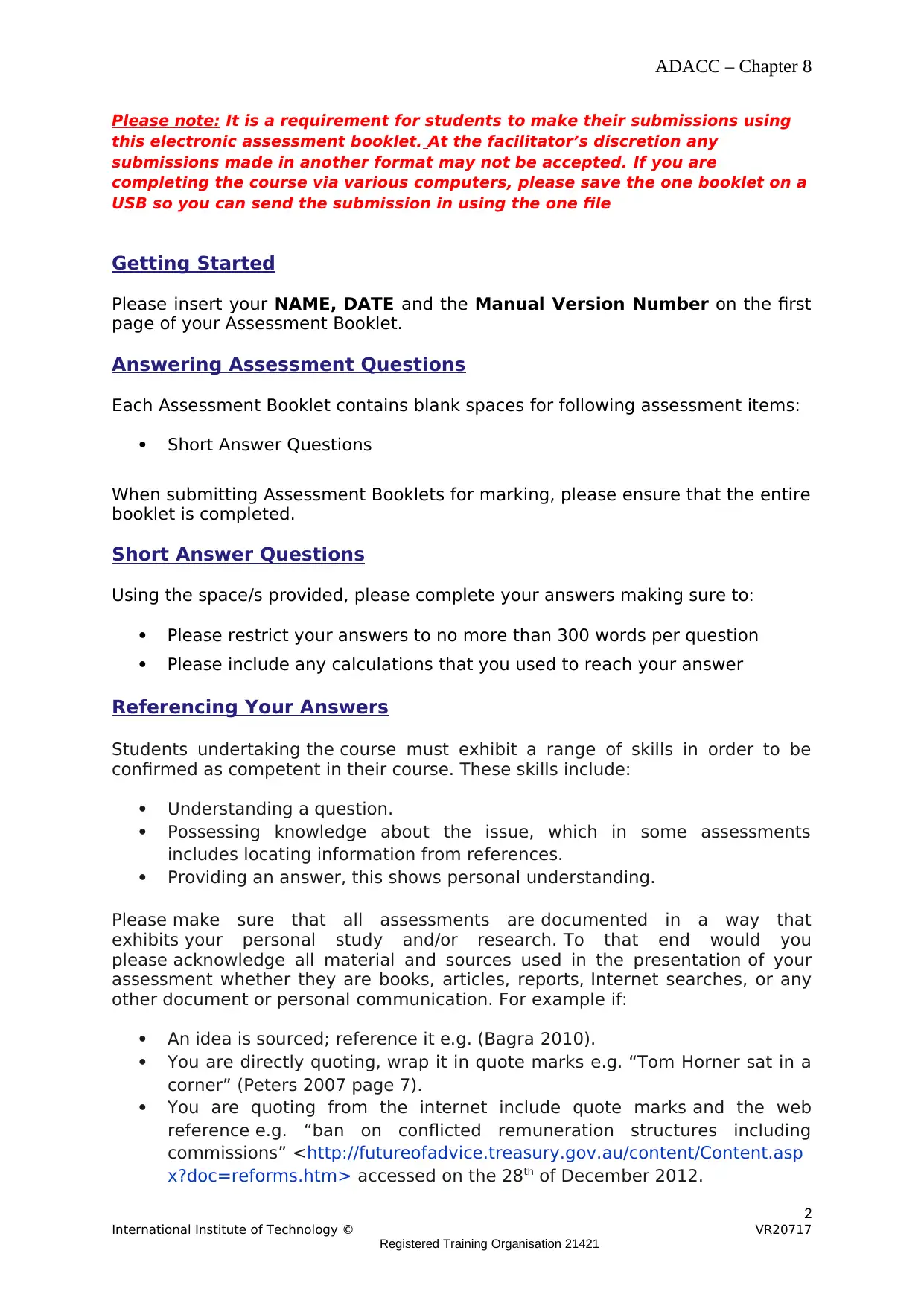
ADACC – Chapter 8
Please note: It is a requirement for students to make their submissions using
this electronic assessment booklet. At the facilitator’s discretion any
submissions made in another format may not be accepted. If you are
completing the course via various computers, please save the one booklet on a
USB so you can send the submission in using the one file
Getting Started
Please insert your NAME, DATE and the Manual Version Number on the first
page of your Assessment Booklet.
Answering Assessment Questions
Each Assessment Booklet contains blank spaces for following assessment items:
Short Answer Questions
When submitting Assessment Booklets for marking, please ensure that the entire
booklet is completed.
Short Answer Questions
Using the space/s provided, please complete your answers making sure to:
Please restrict your answers to no more than 300 words per question
Please include any calculations that you used to reach your answer
Referencing Your Answers
Students undertaking the course must exhibit a range of skills in order to be
confirmed as competent in their course. These skills include:
Understanding a question.
Possessing knowledge about the issue, which in some assessments
includes locating information from references.
Providing an answer, this shows personal understanding.
Please make sure that all assessments are documented in a way that
exhibits your personal study and/or research. To that end would you
please acknowledge all material and sources used in the presentation of your
assessment whether they are books, articles, reports, Internet searches, or any
other document or personal communication. For example if:
An idea is sourced; reference it e.g. (Bagra 2010).
You are directly quoting, wrap it in quote marks e.g. “Tom Horner sat in a
corner” (Peters 2007 page 7).
You are quoting from the internet include quote marks and the web
reference e.g. “ban on conflicted remuneration structures including
commissions” <http://futureofadvice.treasury.gov.au/content/Content.asp
x?doc=reforms.htm> accessed on the 28th of December 2012.
2
International Institute of Technology © VR20717
Registered Training Organisation 21421
Please note: It is a requirement for students to make their submissions using
this electronic assessment booklet. At the facilitator’s discretion any
submissions made in another format may not be accepted. If you are
completing the course via various computers, please save the one booklet on a
USB so you can send the submission in using the one file
Getting Started
Please insert your NAME, DATE and the Manual Version Number on the first
page of your Assessment Booklet.
Answering Assessment Questions
Each Assessment Booklet contains blank spaces for following assessment items:
Short Answer Questions
When submitting Assessment Booklets for marking, please ensure that the entire
booklet is completed.
Short Answer Questions
Using the space/s provided, please complete your answers making sure to:
Please restrict your answers to no more than 300 words per question
Please include any calculations that you used to reach your answer
Referencing Your Answers
Students undertaking the course must exhibit a range of skills in order to be
confirmed as competent in their course. These skills include:
Understanding a question.
Possessing knowledge about the issue, which in some assessments
includes locating information from references.
Providing an answer, this shows personal understanding.
Please make sure that all assessments are documented in a way that
exhibits your personal study and/or research. To that end would you
please acknowledge all material and sources used in the presentation of your
assessment whether they are books, articles, reports, Internet searches, or any
other document or personal communication. For example if:
An idea is sourced; reference it e.g. (Bagra 2010).
You are directly quoting, wrap it in quote marks e.g. “Tom Horner sat in a
corner” (Peters 2007 page 7).
You are quoting from the internet include quote marks and the web
reference e.g. “ban on conflicted remuneration structures including
commissions” <http://futureofadvice.treasury.gov.au/content/Content.asp
x?doc=reforms.htm> accessed on the 28th of December 2012.
2
International Institute of Technology © VR20717
Registered Training Organisation 21421
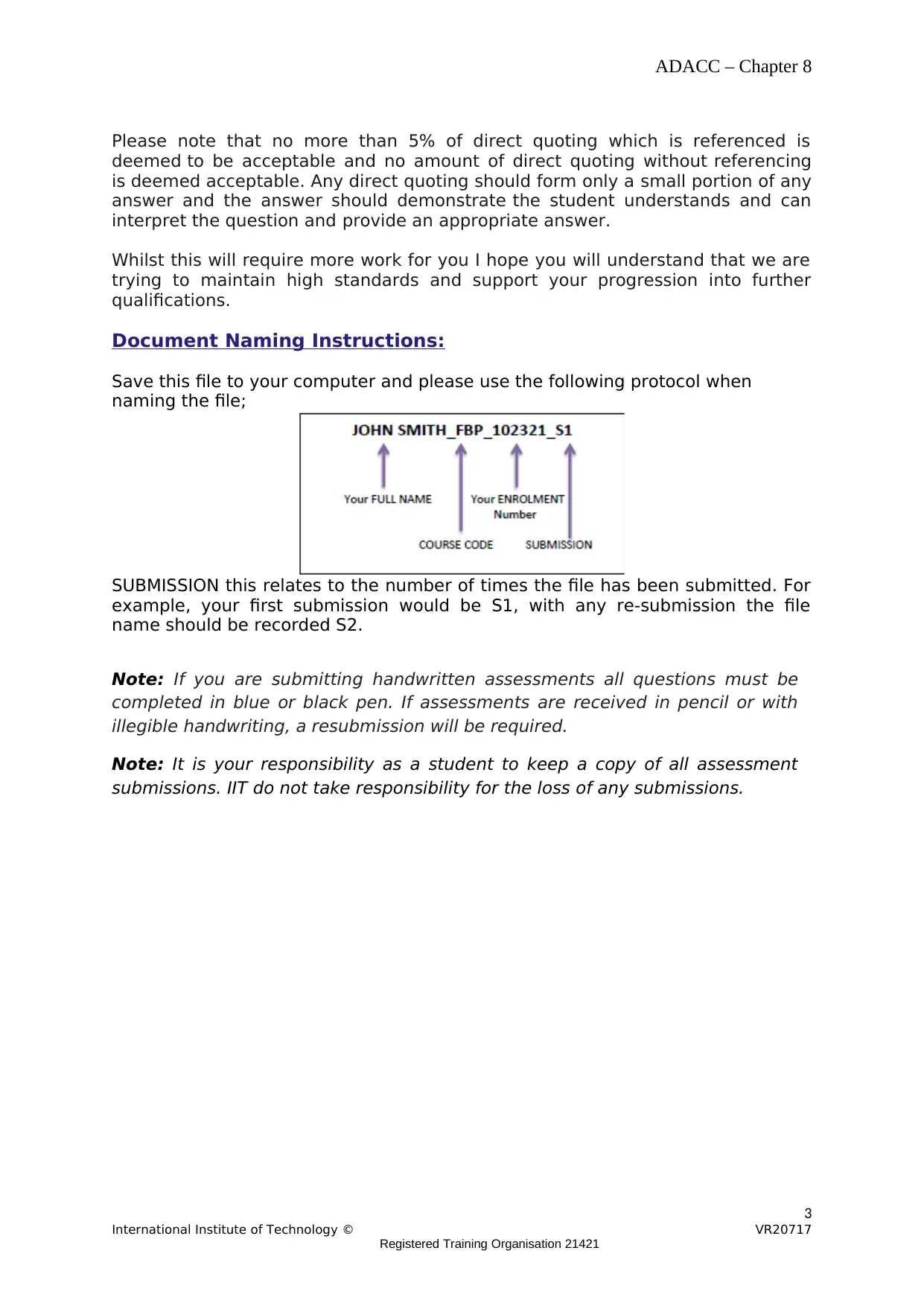
ADACC – Chapter 8
Please note that no more than 5% of direct quoting which is referenced is
deemed to be acceptable and no amount of direct quoting without referencing
is deemed acceptable. Any direct quoting should form only a small portion of any
answer and the answer should demonstrate the student understands and can
interpret the question and provide an appropriate answer.
Whilst this will require more work for you I hope you will understand that we are
trying to maintain high standards and support your progression into further
qualifications.
Document Naming Instructions:
Save this file to your computer and please use the following protocol when
naming the file;
SUBMISSION this relates to the number of times the file has been submitted. For
example, your first submission would be S1, with any re-submission the file
name should be recorded S2.
Note: If you are submitting handwritten assessments all questions must be
completed in blue or black pen. If assessments are received in pencil or with
illegible handwriting, a resubmission will be required.
Note: It is your responsibility as a student to keep a copy of all assessment
submissions. IIT do not take responsibility for the loss of any submissions.
Distance Education Students
3
International Institute of Technology © VR20717
Registered Training Organisation 21421
Please note that no more than 5% of direct quoting which is referenced is
deemed to be acceptable and no amount of direct quoting without referencing
is deemed acceptable. Any direct quoting should form only a small portion of any
answer and the answer should demonstrate the student understands and can
interpret the question and provide an appropriate answer.
Whilst this will require more work for you I hope you will understand that we are
trying to maintain high standards and support your progression into further
qualifications.
Document Naming Instructions:
Save this file to your computer and please use the following protocol when
naming the file;
SUBMISSION this relates to the number of times the file has been submitted. For
example, your first submission would be S1, with any re-submission the file
name should be recorded S2.
Note: If you are submitting handwritten assessments all questions must be
completed in blue or black pen. If assessments are received in pencil or with
illegible handwriting, a resubmission will be required.
Note: It is your responsibility as a student to keep a copy of all assessment
submissions. IIT do not take responsibility for the loss of any submissions.
Distance Education Students
3
International Institute of Technology © VR20717
Registered Training Organisation 21421
⊘ This is a preview!⊘
Do you want full access?
Subscribe today to unlock all pages.

Trusted by 1+ million students worldwide
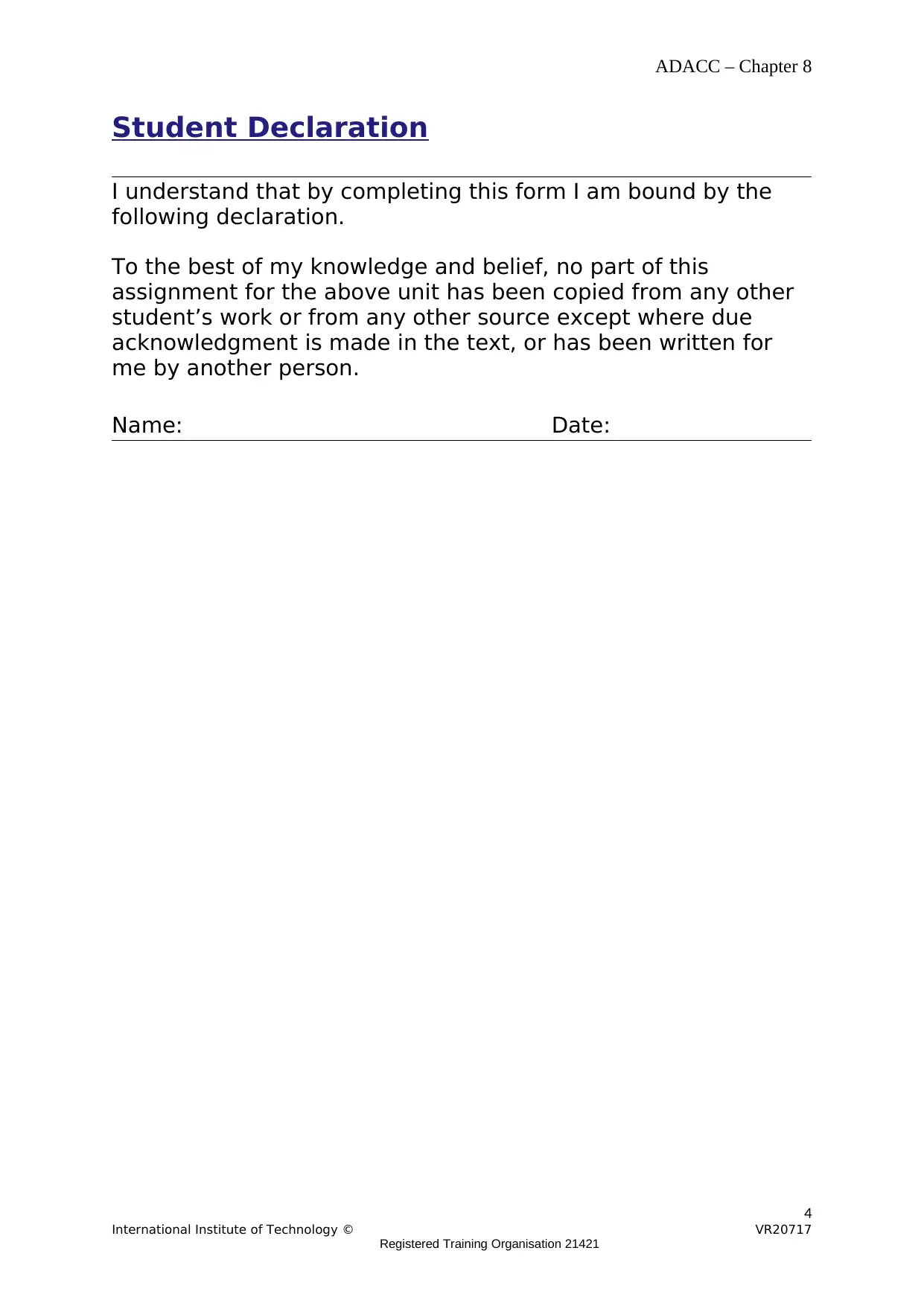
ADACC – Chapter 8
Student Declaration
I understand that by completing this form I am bound by the
following declaration.
To the best of my knowledge and belief, no part of this
assignment for the above unit has been copied from any other
student’s work or from any other source except where due
acknowledgment is made in the text, or has been written for
me by another person.
Name: Date:
4
International Institute of Technology © VR20717
Registered Training Organisation 21421
Student Declaration
I understand that by completing this form I am bound by the
following declaration.
To the best of my knowledge and belief, no part of this
assignment for the above unit has been copied from any other
student’s work or from any other source except where due
acknowledgment is made in the text, or has been written for
me by another person.
Name: Date:
4
International Institute of Technology © VR20717
Registered Training Organisation 21421
Paraphrase This Document
Need a fresh take? Get an instant paraphrase of this document with our AI Paraphraser
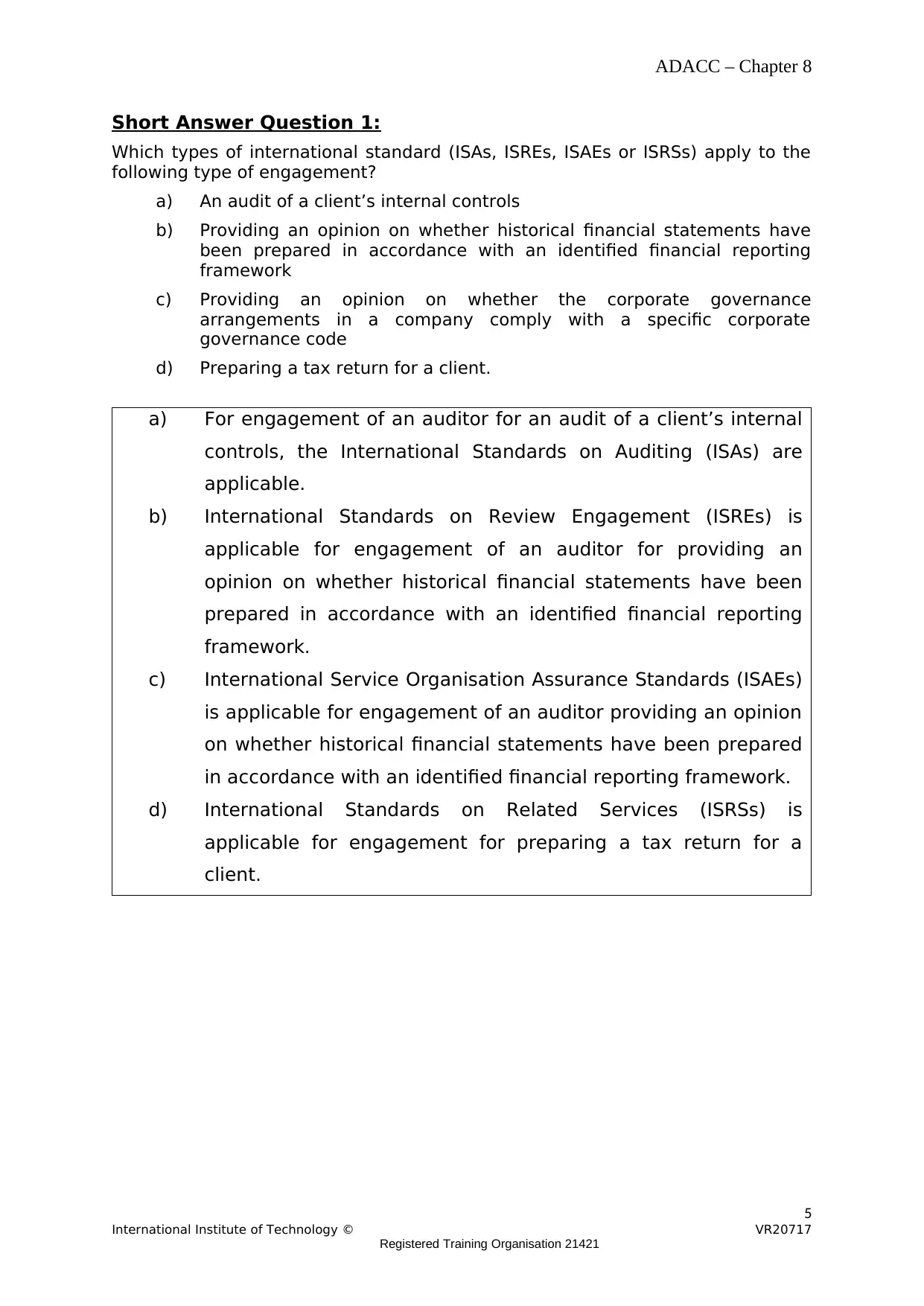
ADACC – Chapter 8
Short Answer Question 1:
Which types of international standard (ISAs, ISREs, ISAEs or ISRSs) apply to the
following type of engagement?
a) An audit of a client’s internal controls
b) Providing an opinion on whether historical financial statements have
been prepared in accordance with an identified financial reporting
framework
c) Providing an opinion on whether the corporate governance
arrangements in a company comply with a specific corporate
governance code
d) Preparing a tax return for a client.
a) For engagement of an auditor for an audit of a client’s internal
controls, the International Standards on Auditing (ISAs) are
applicable.
b) International Standards on Review Engagement (ISREs) is
applicable for engagement of an auditor for providing an
opinion on whether historical financial statements have been
prepared in accordance with an identified financial reporting
framework.
c) International Service Organisation Assurance Standards (ISAEs)
is applicable for engagement of an auditor providing an opinion
on whether historical financial statements have been prepared
in accordance with an identified financial reporting framework.
d) International Standards on Related Services (ISRSs) is
applicable for engagement for preparing a tax return for a
client.
5
International Institute of Technology © VR20717
Registered Training Organisation 21421
Short Answer Question 1:
Which types of international standard (ISAs, ISREs, ISAEs or ISRSs) apply to the
following type of engagement?
a) An audit of a client’s internal controls
b) Providing an opinion on whether historical financial statements have
been prepared in accordance with an identified financial reporting
framework
c) Providing an opinion on whether the corporate governance
arrangements in a company comply with a specific corporate
governance code
d) Preparing a tax return for a client.
a) For engagement of an auditor for an audit of a client’s internal
controls, the International Standards on Auditing (ISAs) are
applicable.
b) International Standards on Review Engagement (ISREs) is
applicable for engagement of an auditor for providing an
opinion on whether historical financial statements have been
prepared in accordance with an identified financial reporting
framework.
c) International Service Organisation Assurance Standards (ISAEs)
is applicable for engagement of an auditor providing an opinion
on whether historical financial statements have been prepared
in accordance with an identified financial reporting framework.
d) International Standards on Related Services (ISRSs) is
applicable for engagement for preparing a tax return for a
client.
5
International Institute of Technology © VR20717
Registered Training Organisation 21421
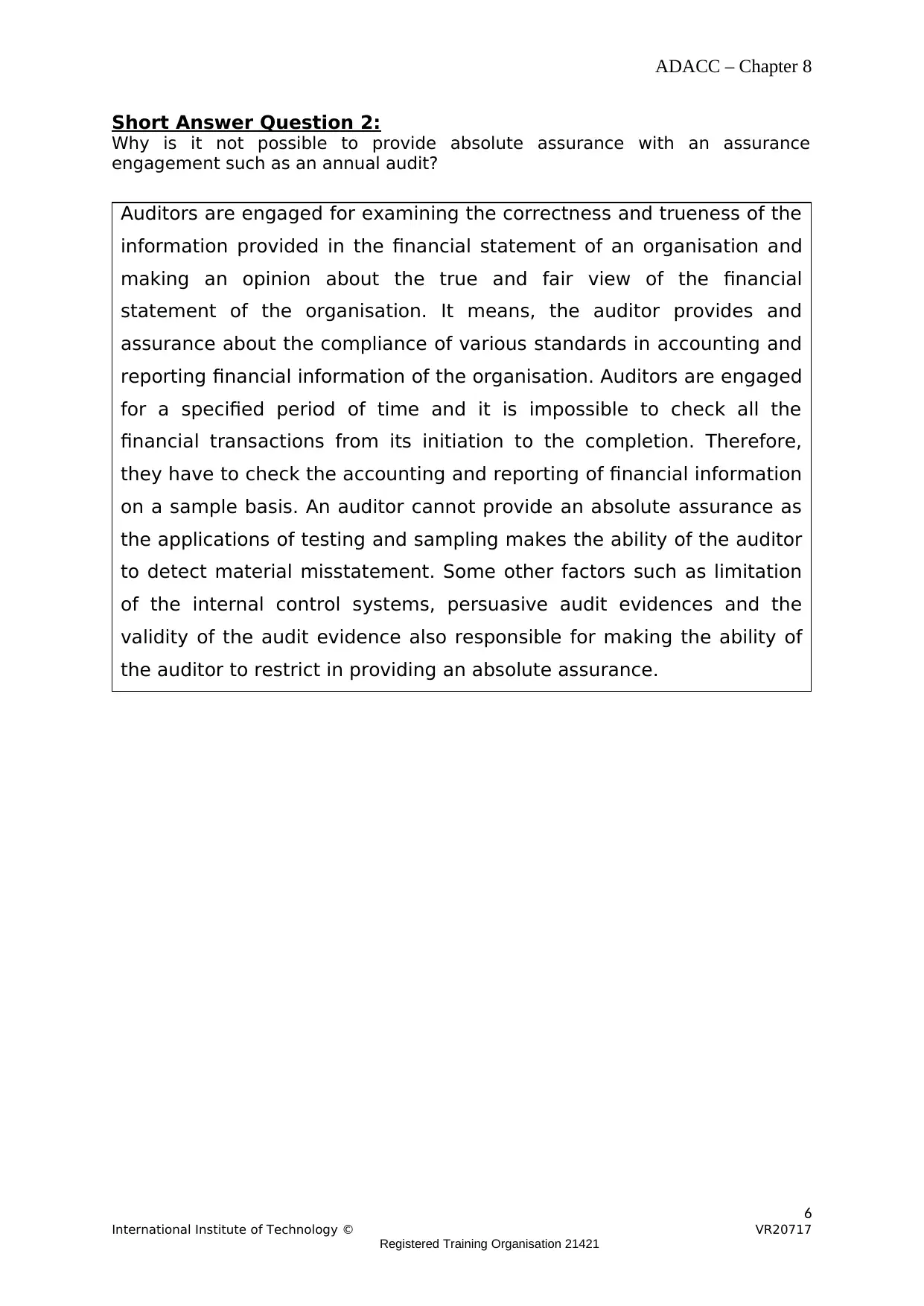
ADACC – Chapter 8
Short Answer Question 2:
Why is it not possible to provide absolute assurance with an assurance
engagement such as an annual audit?
Auditors are engaged for examining the correctness and trueness of the
information provided in the financial statement of an organisation and
making an opinion about the true and fair view of the financial
statement of the organisation. It means, the auditor provides and
assurance about the compliance of various standards in accounting and
reporting financial information of the organisation. Auditors are engaged
for a specified period of time and it is impossible to check all the
financial transactions from its initiation to the completion. Therefore,
they have to check the accounting and reporting of financial information
on a sample basis. An auditor cannot provide an absolute assurance as
the applications of testing and sampling makes the ability of the auditor
to detect material misstatement. Some other factors such as limitation
of the internal control systems, persuasive audit evidences and the
validity of the audit evidence also responsible for making the ability of
the auditor to restrict in providing an absolute assurance.
6
International Institute of Technology © VR20717
Registered Training Organisation 21421
Short Answer Question 2:
Why is it not possible to provide absolute assurance with an assurance
engagement such as an annual audit?
Auditors are engaged for examining the correctness and trueness of the
information provided in the financial statement of an organisation and
making an opinion about the true and fair view of the financial
statement of the organisation. It means, the auditor provides and
assurance about the compliance of various standards in accounting and
reporting financial information of the organisation. Auditors are engaged
for a specified period of time and it is impossible to check all the
financial transactions from its initiation to the completion. Therefore,
they have to check the accounting and reporting of financial information
on a sample basis. An auditor cannot provide an absolute assurance as
the applications of testing and sampling makes the ability of the auditor
to detect material misstatement. Some other factors such as limitation
of the internal control systems, persuasive audit evidences and the
validity of the audit evidence also responsible for making the ability of
the auditor to restrict in providing an absolute assurance.
6
International Institute of Technology © VR20717
Registered Training Organisation 21421
⊘ This is a preview!⊘
Do you want full access?
Subscribe today to unlock all pages.

Trusted by 1+ million students worldwide
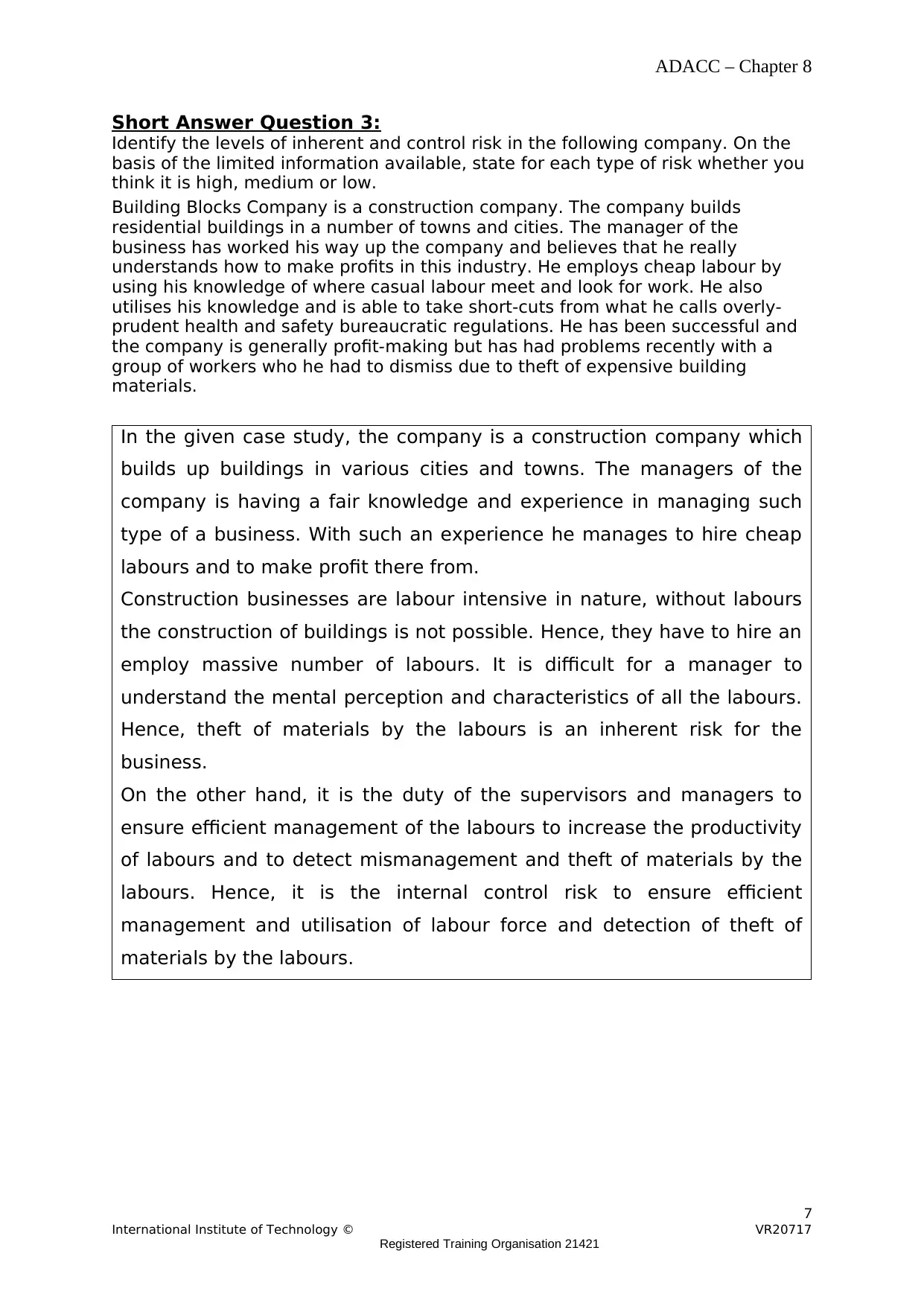
ADACC – Chapter 8
Short Answer Question 3:
Identify the levels of inherent and control risk in the following company. On the
basis of the limited information available, state for each type of risk whether you
think it is high, medium or low.
Building Blocks Company is a construction company. The company builds
residential buildings in a number of towns and cities. The manager of the
business has worked his way up the company and believes that he really
understands how to make profits in this industry. He employs cheap labour by
using his knowledge of where casual labour meet and look for work. He also
utilises his knowledge and is able to take short-cuts from what he calls overly-
prudent health and safety bureaucratic regulations. He has been successful and
the company is generally profit-making but has had problems recently with a
group of workers who he had to dismiss due to theft of expensive building
materials.
In the given case study, the company is a construction company which
builds up buildings in various cities and towns. The managers of the
company is having a fair knowledge and experience in managing such
type of a business. With such an experience he manages to hire cheap
labours and to make profit there from.
Construction businesses are labour intensive in nature, without labours
the construction of buildings is not possible. Hence, they have to hire an
employ massive number of labours. It is difficult for a manager to
understand the mental perception and characteristics of all the labours.
Hence, theft of materials by the labours is an inherent risk for the
business.
On the other hand, it is the duty of the supervisors and managers to
ensure efficient management of the labours to increase the productivity
of labours and to detect mismanagement and theft of materials by the
labours. Hence, it is the internal control risk to ensure efficient
management and utilisation of labour force and detection of theft of
materials by the labours.
7
International Institute of Technology © VR20717
Registered Training Organisation 21421
Short Answer Question 3:
Identify the levels of inherent and control risk in the following company. On the
basis of the limited information available, state for each type of risk whether you
think it is high, medium or low.
Building Blocks Company is a construction company. The company builds
residential buildings in a number of towns and cities. The manager of the
business has worked his way up the company and believes that he really
understands how to make profits in this industry. He employs cheap labour by
using his knowledge of where casual labour meet and look for work. He also
utilises his knowledge and is able to take short-cuts from what he calls overly-
prudent health and safety bureaucratic regulations. He has been successful and
the company is generally profit-making but has had problems recently with a
group of workers who he had to dismiss due to theft of expensive building
materials.
In the given case study, the company is a construction company which
builds up buildings in various cities and towns. The managers of the
company is having a fair knowledge and experience in managing such
type of a business. With such an experience he manages to hire cheap
labours and to make profit there from.
Construction businesses are labour intensive in nature, without labours
the construction of buildings is not possible. Hence, they have to hire an
employ massive number of labours. It is difficult for a manager to
understand the mental perception and characteristics of all the labours.
Hence, theft of materials by the labours is an inherent risk for the
business.
On the other hand, it is the duty of the supervisors and managers to
ensure efficient management of the labours to increase the productivity
of labours and to detect mismanagement and theft of materials by the
labours. Hence, it is the internal control risk to ensure efficient
management and utilisation of labour force and detection of theft of
materials by the labours.
7
International Institute of Technology © VR20717
Registered Training Organisation 21421
Paraphrase This Document
Need a fresh take? Get an instant paraphrase of this document with our AI Paraphraser
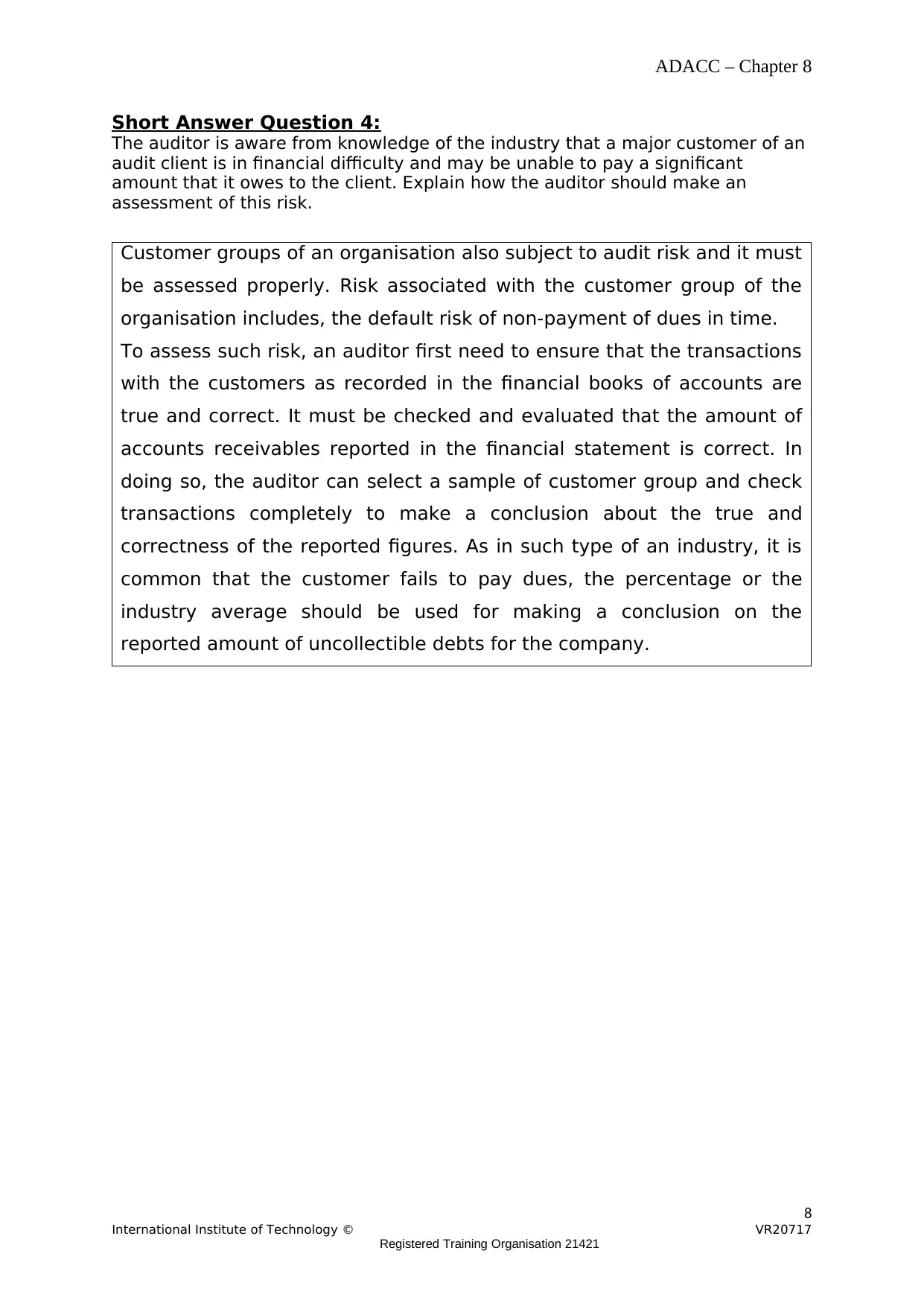
ADACC – Chapter 8
Short Answer Question 4:
The auditor is aware from knowledge of the industry that a major customer of an
audit client is in financial difficulty and may be unable to pay a significant
amount that it owes to the client. Explain how the auditor should make an
assessment of this risk.
Customer groups of an organisation also subject to audit risk and it must
be assessed properly. Risk associated with the customer group of the
organisation includes, the default risk of non-payment of dues in time.
To assess such risk, an auditor first need to ensure that the transactions
with the customers as recorded in the financial books of accounts are
true and correct. It must be checked and evaluated that the amount of
accounts receivables reported in the financial statement is correct. In
doing so, the auditor can select a sample of customer group and check
transactions completely to make a conclusion about the true and
correctness of the reported figures. As in such type of an industry, it is
common that the customer fails to pay dues, the percentage or the
industry average should be used for making a conclusion on the
reported amount of uncollectible debts for the company.
8
International Institute of Technology © VR20717
Registered Training Organisation 21421
Short Answer Question 4:
The auditor is aware from knowledge of the industry that a major customer of an
audit client is in financial difficulty and may be unable to pay a significant
amount that it owes to the client. Explain how the auditor should make an
assessment of this risk.
Customer groups of an organisation also subject to audit risk and it must
be assessed properly. Risk associated with the customer group of the
organisation includes, the default risk of non-payment of dues in time.
To assess such risk, an auditor first need to ensure that the transactions
with the customers as recorded in the financial books of accounts are
true and correct. It must be checked and evaluated that the amount of
accounts receivables reported in the financial statement is correct. In
doing so, the auditor can select a sample of customer group and check
transactions completely to make a conclusion about the true and
correctness of the reported figures. As in such type of an industry, it is
common that the customer fails to pay dues, the percentage or the
industry average should be used for making a conclusion on the
reported amount of uncollectible debts for the company.
8
International Institute of Technology © VR20717
Registered Training Organisation 21421
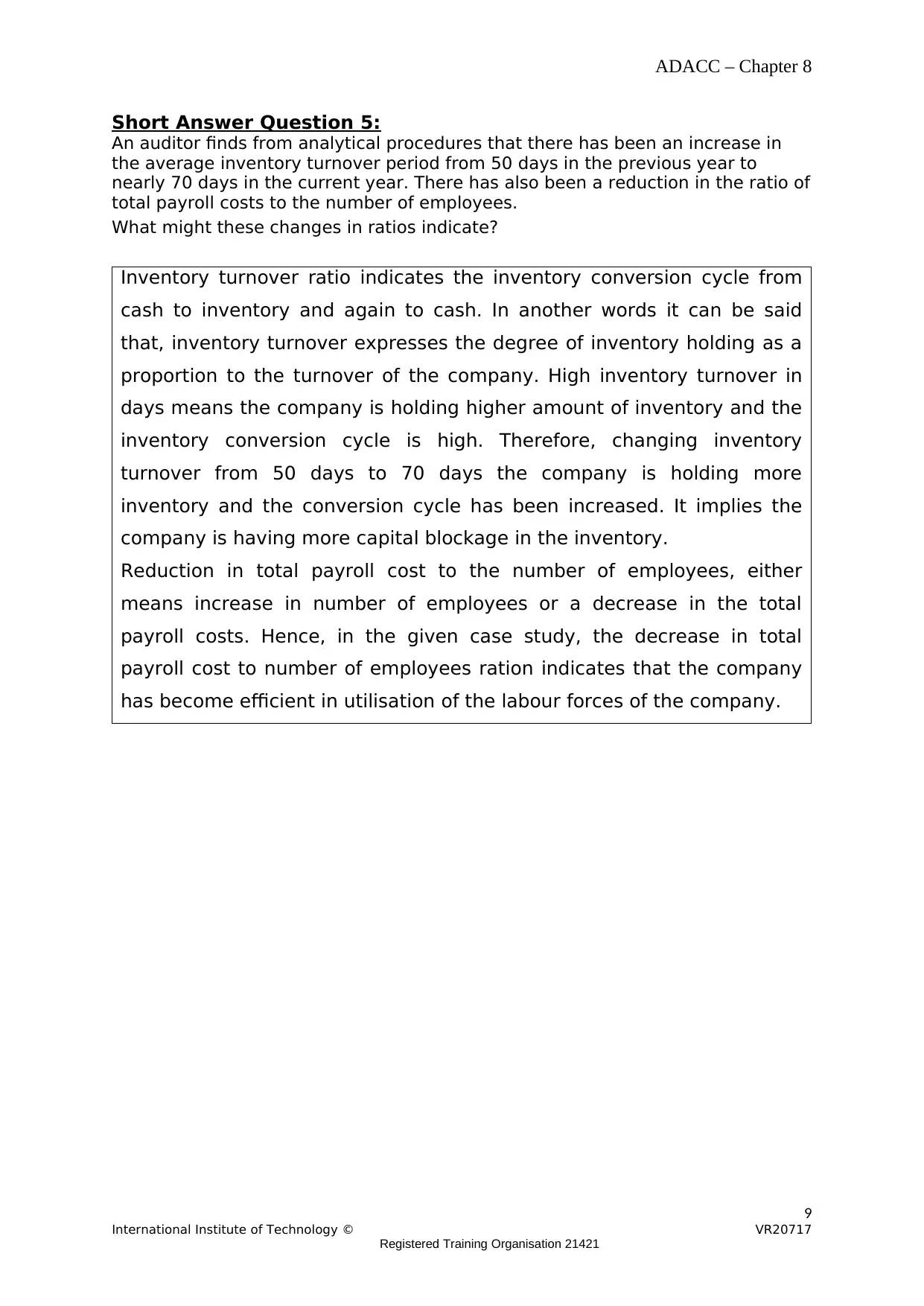
ADACC – Chapter 8
Short Answer Question 5:
An auditor finds from analytical procedures that there has been an increase in
the average inventory turnover period from 50 days in the previous year to
nearly 70 days in the current year. There has also been a reduction in the ratio of
total payroll costs to the number of employees.
What might these changes in ratios indicate?
Inventory turnover ratio indicates the inventory conversion cycle from
cash to inventory and again to cash. In another words it can be said
that, inventory turnover expresses the degree of inventory holding as a
proportion to the turnover of the company. High inventory turnover in
days means the company is holding higher amount of inventory and the
inventory conversion cycle is high. Therefore, changing inventory
turnover from 50 days to 70 days the company is holding more
inventory and the conversion cycle has been increased. It implies the
company is having more capital blockage in the inventory.
Reduction in total payroll cost to the number of employees, either
means increase in number of employees or a decrease in the total
payroll costs. Hence, in the given case study, the decrease in total
payroll cost to number of employees ration indicates that the company
has become efficient in utilisation of the labour forces of the company.
9
International Institute of Technology © VR20717
Registered Training Organisation 21421
Short Answer Question 5:
An auditor finds from analytical procedures that there has been an increase in
the average inventory turnover period from 50 days in the previous year to
nearly 70 days in the current year. There has also been a reduction in the ratio of
total payroll costs to the number of employees.
What might these changes in ratios indicate?
Inventory turnover ratio indicates the inventory conversion cycle from
cash to inventory and again to cash. In another words it can be said
that, inventory turnover expresses the degree of inventory holding as a
proportion to the turnover of the company. High inventory turnover in
days means the company is holding higher amount of inventory and the
inventory conversion cycle is high. Therefore, changing inventory
turnover from 50 days to 70 days the company is holding more
inventory and the conversion cycle has been increased. It implies the
company is having more capital blockage in the inventory.
Reduction in total payroll cost to the number of employees, either
means increase in number of employees or a decrease in the total
payroll costs. Hence, in the given case study, the decrease in total
payroll cost to number of employees ration indicates that the company
has become efficient in utilisation of the labour forces of the company.
9
International Institute of Technology © VR20717
Registered Training Organisation 21421
⊘ This is a preview!⊘
Do you want full access?
Subscribe today to unlock all pages.

Trusted by 1+ million students worldwide
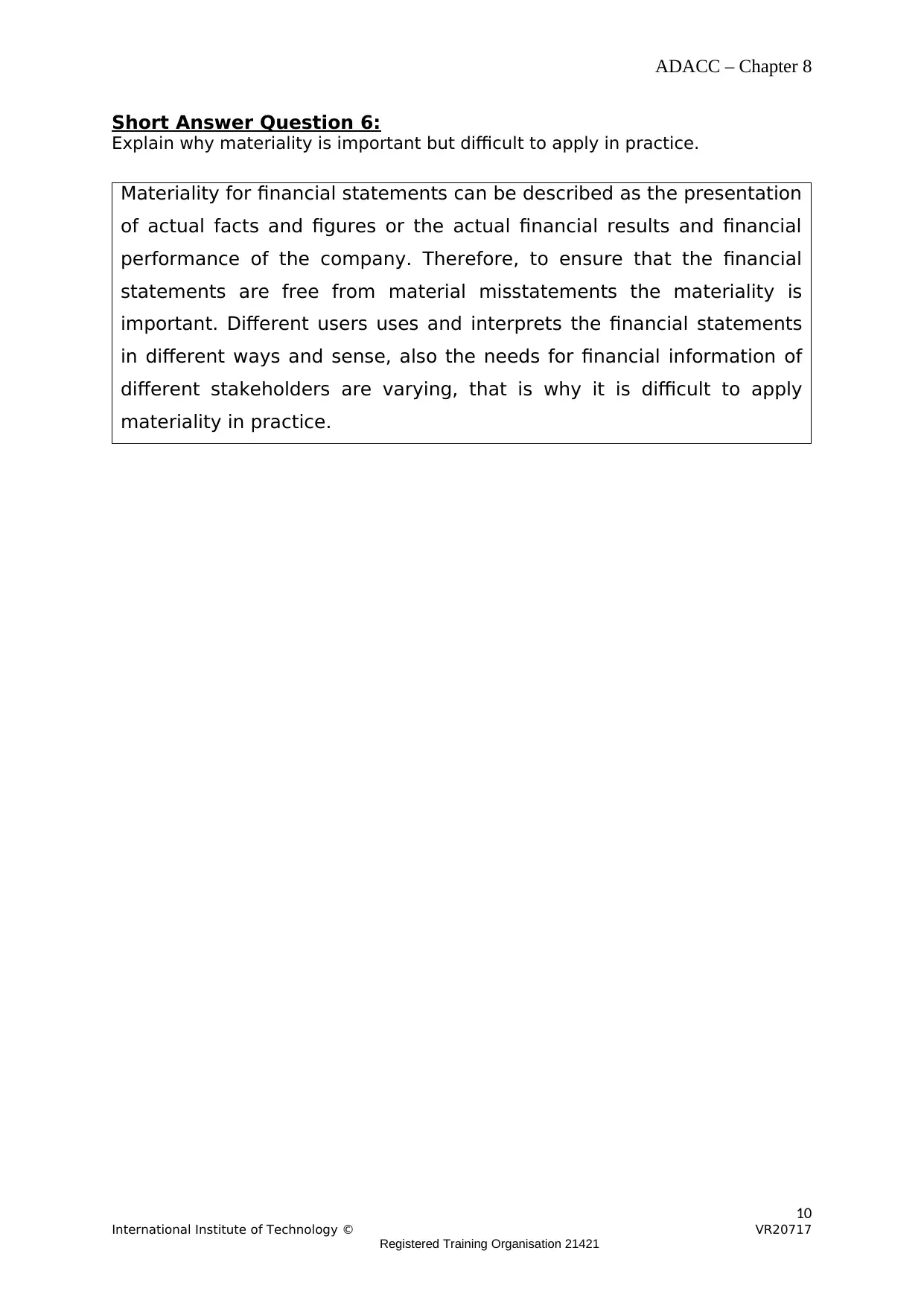
ADACC – Chapter 8
Short Answer Question 6:
Explain why materiality is important but difficult to apply in practice.
Materiality for financial statements can be described as the presentation
of actual facts and figures or the actual financial results and financial
performance of the company. Therefore, to ensure that the financial
statements are free from material misstatements the materiality is
important. Different users uses and interprets the financial statements
in different ways and sense, also the needs for financial information of
different stakeholders are varying, that is why it is difficult to apply
materiality in practice.
10
International Institute of Technology © VR20717
Registered Training Organisation 21421
Short Answer Question 6:
Explain why materiality is important but difficult to apply in practice.
Materiality for financial statements can be described as the presentation
of actual facts and figures or the actual financial results and financial
performance of the company. Therefore, to ensure that the financial
statements are free from material misstatements the materiality is
important. Different users uses and interprets the financial statements
in different ways and sense, also the needs for financial information of
different stakeholders are varying, that is why it is difficult to apply
materiality in practice.
10
International Institute of Technology © VR20717
Registered Training Organisation 21421
Paraphrase This Document
Need a fresh take? Get an instant paraphrase of this document with our AI Paraphraser
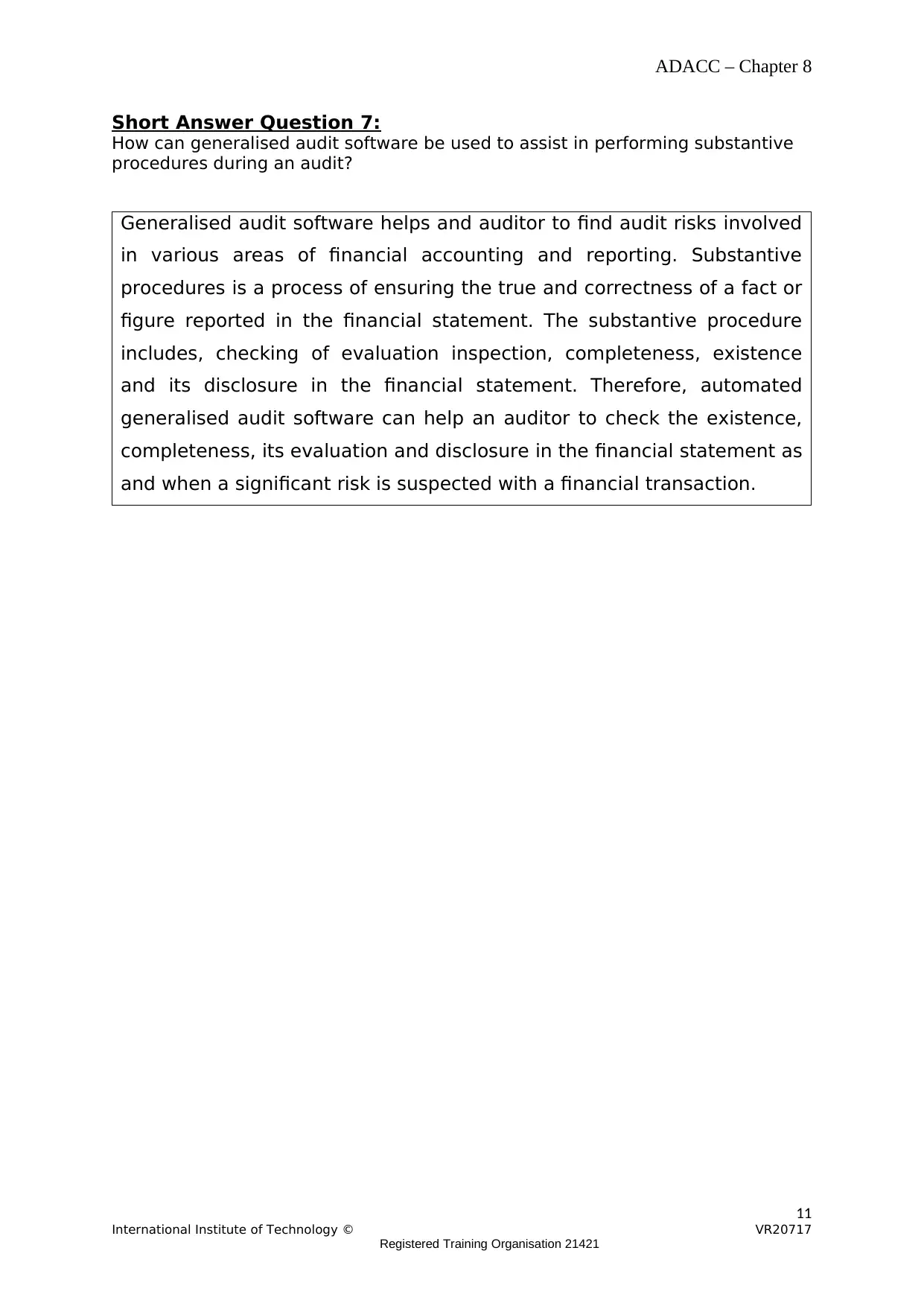
ADACC – Chapter 8
Short Answer Question 7:
How can generalised audit software be used to assist in performing substantive
procedures during an audit?
Generalised audit software helps and auditor to find audit risks involved
in various areas of financial accounting and reporting. Substantive
procedures is a process of ensuring the true and correctness of a fact or
figure reported in the financial statement. The substantive procedure
includes, checking of evaluation inspection, completeness, existence
and its disclosure in the financial statement. Therefore, automated
generalised audit software can help an auditor to check the existence,
completeness, its evaluation and disclosure in the financial statement as
and when a significant risk is suspected with a financial transaction.
11
International Institute of Technology © VR20717
Registered Training Organisation 21421
Short Answer Question 7:
How can generalised audit software be used to assist in performing substantive
procedures during an audit?
Generalised audit software helps and auditor to find audit risks involved
in various areas of financial accounting and reporting. Substantive
procedures is a process of ensuring the true and correctness of a fact or
figure reported in the financial statement. The substantive procedure
includes, checking of evaluation inspection, completeness, existence
and its disclosure in the financial statement. Therefore, automated
generalised audit software can help an auditor to check the existence,
completeness, its evaluation and disclosure in the financial statement as
and when a significant risk is suspected with a financial transaction.
11
International Institute of Technology © VR20717
Registered Training Organisation 21421
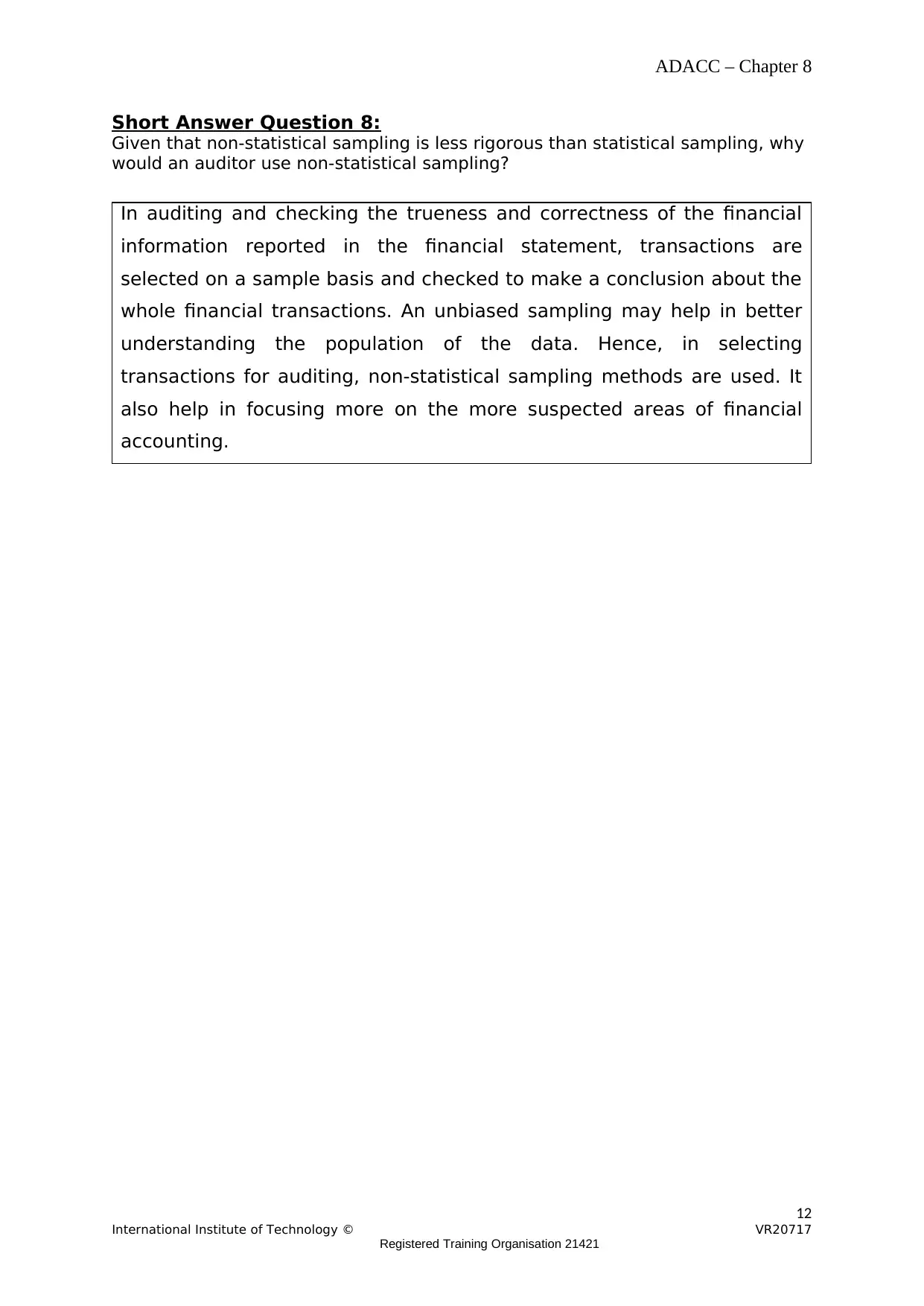
ADACC – Chapter 8
Short Answer Question 8:
Given that non-statistical sampling is less rigorous than statistical sampling, why
would an auditor use non-statistical sampling?
In auditing and checking the trueness and correctness of the financial
information reported in the financial statement, transactions are
selected on a sample basis and checked to make a conclusion about the
whole financial transactions. An unbiased sampling may help in better
understanding the population of the data. Hence, in selecting
transactions for auditing, non-statistical sampling methods are used. It
also help in focusing more on the more suspected areas of financial
accounting.
12
International Institute of Technology © VR20717
Registered Training Organisation 21421
Short Answer Question 8:
Given that non-statistical sampling is less rigorous than statistical sampling, why
would an auditor use non-statistical sampling?
In auditing and checking the trueness and correctness of the financial
information reported in the financial statement, transactions are
selected on a sample basis and checked to make a conclusion about the
whole financial transactions. An unbiased sampling may help in better
understanding the population of the data. Hence, in selecting
transactions for auditing, non-statistical sampling methods are used. It
also help in focusing more on the more suspected areas of financial
accounting.
12
International Institute of Technology © VR20717
Registered Training Organisation 21421
⊘ This is a preview!⊘
Do you want full access?
Subscribe today to unlock all pages.

Trusted by 1+ million students worldwide
1 out of 22
Related Documents
Your All-in-One AI-Powered Toolkit for Academic Success.
+13062052269
info@desklib.com
Available 24*7 on WhatsApp / Email
![[object Object]](/_next/static/media/star-bottom.7253800d.svg)
Unlock your academic potential
Copyright © 2020–2025 A2Z Services. All Rights Reserved. Developed and managed by ZUCOL.





